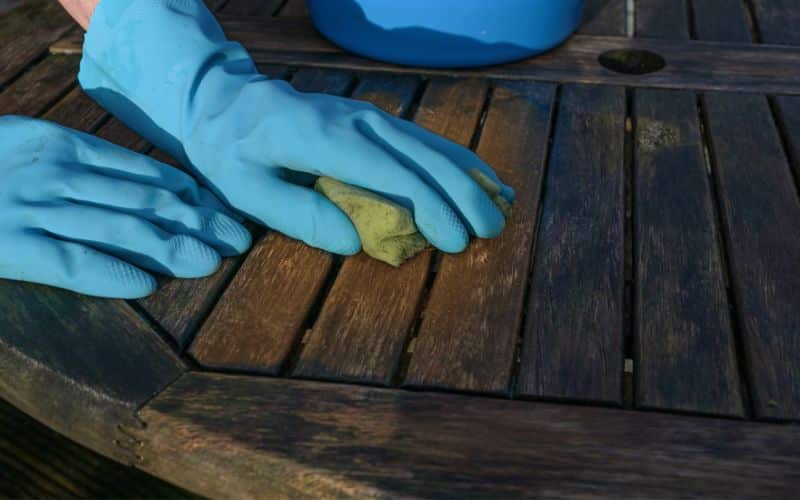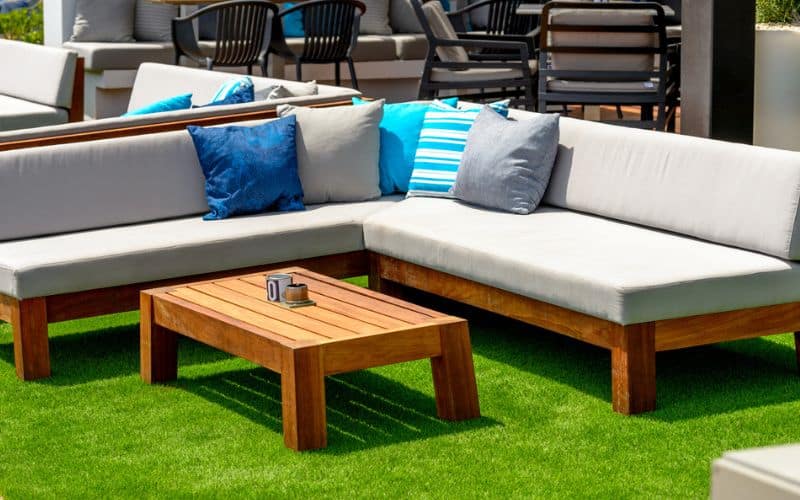
Kick-starting Your Outdoor Furniture Journey
The appeal of outdoor furniture lies in the delightful prospect of soaking up the sun and appreciating nature’s tranquility. However, maintaining their allure amidst the challenging outdoor elements calls for dedication and a practical approach.
Identifying Your Outdoor Furniture Type
The first step towards successful maintenance is recognizing your furniture type. Outdoor pieces can be broadly categorized into four types, each with unique characteristics:
Wood: Durable yet elegant, wooden furniture brings a warm, earthy touch to your patio. However, the charm comes with susceptibility to moisture, sunlight, and pests. To preserve its natural look, wooden furniture requires consistent cleaning, sanding, and sealing.
Metal: Furniture made from metals like wrought iron or aluminum offers a sleek look coupled with long-lasting durability. However, rust and oxidation pose threats to its longevity. Consistent cleaning, rust removal, and protective finish application can keep your metal furniture rust-free and gleaming.
Plastic: Plastic outdoor furniture is the go-to for many, thanks to its affordability and lightweight nature. Despite its durability, UV rays can cause discoloration or brittleness over time. Regular cleaning and proper storage during extreme weather conditions will keep your plastic furniture vibrant and long-lasting.
Fabric: Outdoor furniture pieces sporting fabric accents like cushions or upholstery demand extra care. To maintain their appeal and durability, they need regular cleaning, spot treatment, and protective covers during harsh weather conditions.
Cleaning 101: Keeping Your Outdoor Furniture Spotless
The secret to keeping your outdoor furniture in top shape lies in effective cleaning. Here’s a simple guide to cleaning each furniture type:
Wood
Brush off loose dirt with a soft cloth or brush.
Gently scrub the wood with a soap-water solution.
Rinse thoroughly and dry completely before applying a sealant or outdoor wood oil.
Metal
Remove dust and grime with a damp cloth.
If rust is evident, use sandpaper or a wire brush to eliminate it.
Clean the metal with a soap-water solution, rinse well, and dry it off to prevent water spots.
Apply a rust-resistant primer and paint or a protective wax coating.
Plastic
Prepare a soap-water solution.
Use a sponge or soft brush to scrub the furniture.
Rinse thoroughly and air dry.
Fabric
Brush or shake off any loose dirt.
Spot clean stains with mild detergent or fabric cleaner.
Rinse and allow it to air dry completely.

Eco-friendly Approach: Cleaning with a Conscience
In the pursuit of an eco-friendly lifestyle, our spotlight is on a remarkable product:
[Product Name]: This outdoor furniture cleaner, apart from being effective against dirt and stains, is a testament to eco-conscious practices. Biodegradable and devoid of harsh chemicals, it is safe for your garden life and pets.
For effective usage:
- Shake well before use.
- Spray evenly on furniture surfaces.
- Let it sit for a few minutes for stain penetration.
- Scrub gently and rinse thoroughly.
- Regular usage helps maintain your outdoor pieces while keeping your ecological footprint in check.
Weatherproofing: Protecting Your Furniture from the Elements
Weatherproofing your outdoor furniture is integral to its longevity. Here are a few tips:
Apply a protective finish: Sealant, varnish, or outdoor paint can offer protection against moisture and UV rays.
Use covers or storage: During bad weather, consider using covers or storing furniture in a dry, sheltered area.
Provide shade: Position furniture under a shade to minimize sun exposure.
Elevate furniture: Using blocks or furniture pads can keep your furniture away from wet ground.
Regular inspections: Keep an eye on any wear or damage and promptly address any issues.

Seasonal Care: Tending to Your Outdoor Furniture Throughout the Year
Different seasons bring varying challenges for outdoor furniture. Here are seasonal tips:
Spring: Reviving Your Furniture Post-Winter
With the harsh winter months coming to an end, spring marks a fresh beginning for your outdoor furniture. Thoroughly clean every piece, paying particular attention to any areas that might have suffered damage or wear during the winter. If needed, apply protective finishes, especially on wooden or metal furniture. Spring is also an ideal time to check for any pests that might have taken refuge in your furniture during winter.
Summer: The Season of Regular Checks and Quick Action
Summer, with its bright sunshine and high temperatures, requires you to keep a keen eye on your outdoor pieces. Regular cleaning is crucial to remove sweat, food spills, and other summer-specific stains. Moreover, it’s essential to look for signs of rust or mold, which can set in quickly during the warm, humid months. Address these issues promptly to prevent long-term damage. If your furniture doesn’t have inherent UV protection, consider using protective covers during peak sunlight hours to minimize potential fading or heat damage.
Fall: Preparing Your Furniture for the Onset of Cold Weather
As the leaves start falling and temperatures drop, your outdoor furniture needs extra care. Regularly sweep off fallen leaves, twigs, and other debris from your furniture to avoid stains or mildew formation. As rainfall can increase during fall, consider storing your furniture or protecting it with waterproof covers. Particularly delicate items, such as cushioned seating, hammocks, or decorative pieces, might benefit from being stored indoors during the fall.
Winter: Safeguarding Your Furniture Against the Harsh Cold
Winter poses significant challenges to your outdoor furniture. Before the cold hits in full force, clean and dry your furniture thoroughly. Moisture left on the furniture can freeze, causing cracks or other damage. To better protect your pieces, consider storing them indoors or in a weatherproof storage area. Removable fabric components, such as cushions or rugs, should be cleaned and stored separately. If indoor storage is not an option, invest in high-quality, weather-resistant covers that can shield your furniture from snow, ice, and freezing temperatures.

Troubleshooting: Addressing Common Outdoor Furniture Issues
Here are some eco-friendly solutions to common outdoor furniture problems:
Rust: Use a paste of baking soda and water to scrub the affected area. Rinse well and apply rust-inhibiting primer and paint.
Mold and Mildew: Use a vinegar-water solution to spray affected areas and scrub off with a brush.
Fading: Apply a UV-resistant sealant to prevent fading and use protective covers during non-use periods.
Conclusion
- Caring for outdoor furniture isn’t a one-season affair. Instead, it’s a continuous process that changes as the seasons do. By adhering to this comprehensive guide, you can protect your outdoor pieces from the diverse challenges each season brings.
- In the spring, breathe new life into your furniture, reviving it from the winter’s grip. Summer demands vigilant maintenance and immediate action at the first signs of trouble. Fall requires preparatory care as the temperatures drop, while winter necessitates thorough cleaning and secure storage or cover.
- Remember, the longevity of your outdoor furniture largely depends on your commitment to its care. By understanding and respecting the rhythm of the seasons, you can ensure your outdoor furniture maintains its beauty and functionality year-round, setting the scene for countless memorable outdoor moments, no matter the season.
Cleaning Outdoor Furniture FAQs
Can I use household cleaners on my outdoor furniture?
It’s advisable to use mild, eco-friendly cleaners specifically formulated for outdoor furniture.
How often should I clean my outdoor furniture?
Aim for at least two thorough cleanings per year, with spot cleaning as needed.
Can I leave my wooden furniture untreated?
Treating your wooden furniture with protective finishes extends its lifespan and maintains its appearance.
Are there any natural remedies for removing stains from fabric cushions?
Yes, baking soda and water or lemon juice and salt can be effective. Always do a spot test before applying.
What should I do if my metal furniture starts to rust?
Remove rust with a wire brush or sandpaper and apply a rust-inhibiting primer and paint.
Colin Macmillan is a seasoned entrepreneur and the CEO of Riverwood Landscape, a leading landscaping company based in Canada. He has been at the helm of the company since leaving high school, demonstrating his strong leadership skills and business acumen.
Colin’s expertise lies in various aspects of landscaping, including lawn care, interlocking, sod installation, and commercial maintenance. His hands-on approach and dedication to the craft have been instrumental in building Riverwood Landscape into a reputable brand.
One of his most notable achievements is the creation of a successful landscape franchise that services multiple locations. This accomplishment underscores his strategic thinking and ability to scale operations effectively.
Colin has also had the privilege of working with Guelph Hospital for landscaping and maintenance, a testament to the trust and reliability that his company has earned over the years.
His professional mission is to offer the best services and experiences for customers, a goal that he tirelessly pursues. Colin’s commitment to excellence and customer satisfaction continues to drive the growth and success of Riverwood Landscape.








